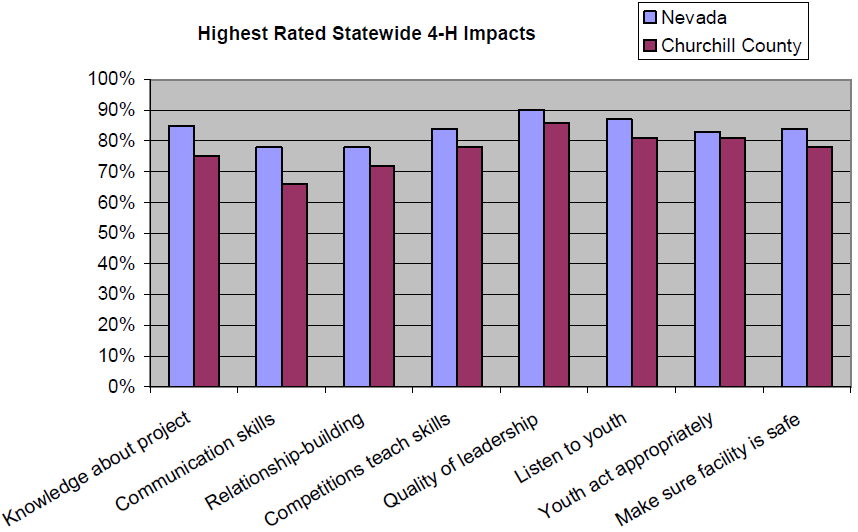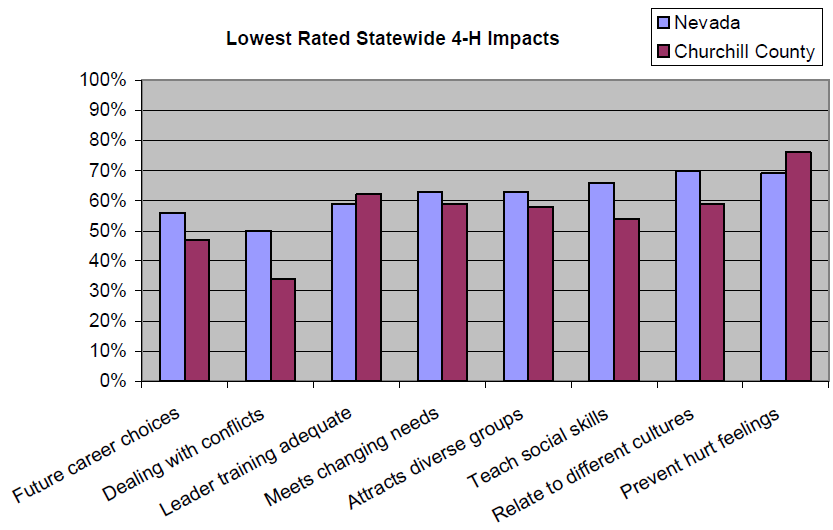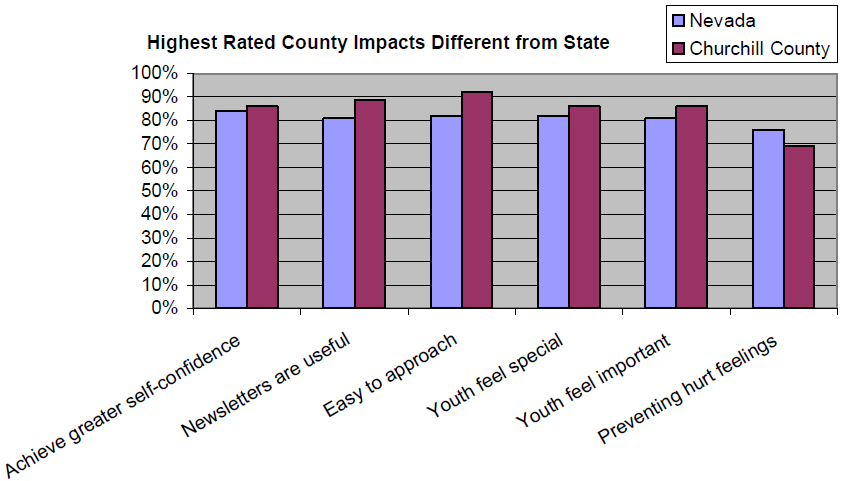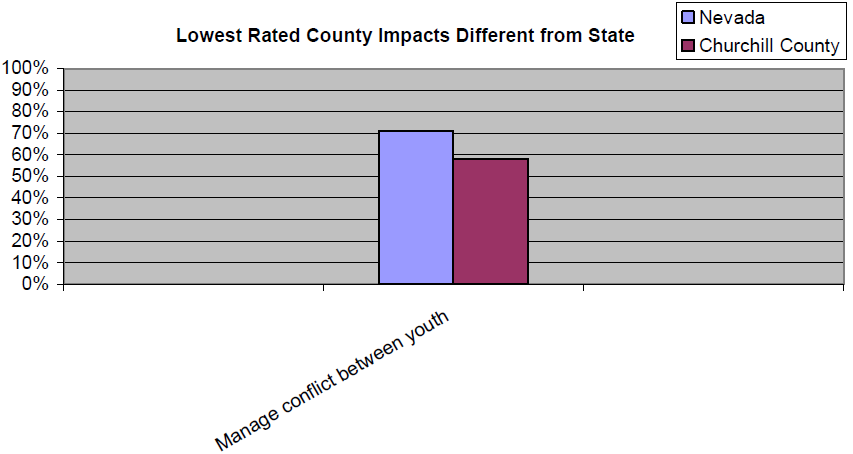Introduction
In continued efforts to assess 4-H program impacts, in 2003, University of Nevada Cooperative Extension surveyed all 4-H parents and leaders statewide. The results were analyzed statewide and by county (Singletary & Smith, 2004). Understanding impacts at the county level is important because 4-H programs in Nevada are managed at the county level. This fact sheet reports the impact assessment results statewide, highlighting Churchill County. The purpose of this report is to inform 4-H parents, leaders and youth members about how 4-H impacts their lives, and also assist 4-H professionals to develop an action plan to further strengthen Churchill County 4-H.
Designing and Conducting the Assessment
In designing a tool to assess 4-H program impacts, two models for youth development were used. The first model is based upon six outcomes to expect from successful youth development. These outcomes are confidence, competence, caring, connection, contributing and character (Blyth, 2000).
Successful youth development helps children become: confident they can make a difference; competent through their ability, skills, and knowledge, and; able to work with people in a way that develops and promotes caring relationships. These youth connect beneficially with people and organizations, contribute their services to make a difference in their personal development as well as in their community, and demonstrate responsible and honest character, or a sense of who they are.
The second youth development model used to develop the assessment questions focuses on “core concepts” and provides a basis for successful youth development programs in Nevada (UNCE, 1993). Such programs produce youth who:
- learn and practice self-responsibility and social responsibility to feel accountable and in control of their lives;
- recognize when and how to make informed decisions and implement decisions to solve a problem or achieve goals;
- communicate effectively in both verbal and written form, to share thoughts and feelings which increase social competence, and;
- obtain career and occupational information to help prepare for the world of work.
Questions developed for this assessment were based upon the six desired outcomes of positive youth development and Nevada’s core concepts for teaching life skills. Combining the two models resulted in a suite of questions that assess the effectiveness of 4-H: to teach youth life skills and social skills; traditional 4-H teaching tools; program management goals; parent and volunteer leader skills to teach youth, manage programs and prevent negative or high-risk behavior among 4-H youth.
These questions were based on skills established by the National Committee on Community Programs to Promote Youth Development (Eccles and Appleton-Gootman, 2002). Questions were designed to assess the indirect impacts of Nevada 4-H on parents and volunteer leaders.
Participants in the assessment included all parents and adult volunteer 4-H leaders currently enrolled statewide and in Churchill County. These participants were selected based on the rationale that 4-H leaders and parents of 4-Hers have the most frequent opportunity to observe any changes that occur among youth participating in 4-H programs.
Each individual was mailed a two-page questionnaire with instructions along with a selfaddressed and stamped return envelope. Also included was a cover letter that explained the purpose of the survey, ensured confidentiality to participants, and thanked them for their participation. Of the 3,074 survey recipients, 576 returned completed questionnaires resulting in a 19 percent response rate statewide. Churchill’s response rate was 20 percent countywide and represented 6 percent of the statewide response.
County Impacts Compared with Statewide Impacts
On a scale of 1 to 5 with “1” being “very low” and “5” being “very high,” respondents were asked to circle the number that best indicates how effectively 4-H is developing youth and impacting the adults involved. The results are presented by highest and lowest ratings. Results from Churchill County are presented alongside statewide impacts for comparison purposes.
Figure 1. Highest Rated Statewide 4-H Program Impacts Compared with Churchill County

Data From Figure 1
The highest rated statewide impacts are shown in Figure 1 along with Churchill County impacts. Individual question labels below each bar set specify the abbreviated survey questions.
Figure 2. Lowest Rated Statewide 4-H Program Impacts Compared with Churchill County

Data From Figure 2
Similarly, Figure 2 illustrates lowest rated impacts statewide along with Churchill County results.
Figure 3. Churchill County Highest Rated 4-H Programs Impacts Different from State

Data From Figure 3
Figure 3 illustrates the highest rated impacts for Churchill County that differ from the statewide results. For example, Churchill County rated the highest life skill 4-H youth learn to achieve greater self-confidence around others (86% countywide and 84% statewide). The highest rated program teaching tool goal is 4-H newsletters are useful ways to teach and announce upcoming events (89% countywide and 81% statewide). In terms of parent/leader skills, Churchill County’s highest rated teaching skill is making sure I’m easy to approach if youth have a problem (92% countywide and 82% statewide). The highest rated parent/leader management skill is helping youth to feel like they belong to a part of a special group tied with helping youth to feel they are an important part of the 4-H program (86% countywide and 82%, 81% statewide respectively). The highest rated parent/leader prevention skill is preventing hurt feelings (76% countywide and 69% statewide).
Figure 4. Churchill County Lowest Rated 4-H Program Impacts Different from State

Data From Figure 4
Figure 4 illustrates the single difference between Churchill County and the state. That is, the lowest rated parent/leader prevent skill is managing conflict between youth (57% countywide and 71% statewide).
Table 1. Churchill County Demographics
| Category |
Amount |
| Number of school-age children in Churchill County |
4,610 |
| Total number of 4-H youth in Churchill County |
195 |
Ethnic distribution of children in Churchill County
AI/NA (7%); AS (5%); H (11%); B (2%); W (75%) |
W (75%) |
Ethnic distribution of 4-H youth in Churchill County
AI/NA (5%); AS (2%); H (6%); B (2%); W (85%) |
W (86%) |
| Median income of families in Churchill County |
$53,100 |
| Income distribution of 4-H families in Churchill County |
$10,000-$149,999 |
| Percent 4-H families in Churchill County earning below $25,000 |
8.6% |
| Percent of families in Churchill County earning below $25,000 |
5.9% |
Developing an Action Plan to Strengthen Churchill County 4-H
To develop an action plan, Churchill County 4-H professionals combined assessment results with available demographic information. Table 1 illustrates these demographics for Churchill County. One particularly notable item concerns Churchill 4- H Club enrollment’s relatively low share of the total number of school-aged children countywide (4%). It also appears that Churchill County 4-H tends to reach mostly white, middle and higher income families. Given the assessment results and the demographic information, the resulting action plan for Churchill County 4-H will:
- Develop and provide training for 4-H youth, parents and leaders directly dealing with conflict management and
- Directly target a specific ethnic group in Churchill County and increase their involvement in the 4-H Program.
A series of workshops will be scheduled throughout the year featuring conflict management skills. The programs will consist of not only lecture but participant involvement such as role plays. All youth and adults in Churchill County will be encouraged to attend. Partnering with after school programs will benefit both organizations.
The Hispanic community will be directly targeted to attract youth and increase ethnic and cultural diversity within the Churchill County 4-H Program. A volunteer will be secured to effectively translate public announcements about 4-H events so we may circulate announcements in Spanish as well as in English. Recruitment of 4-H members and leaders will occur in situations that feature large Hispanic populations such as church services and restaurants.
Conclusions
This fact sheet reported the results of the 2003 University of Nevada Cooperative Extension 4-H program impact assessment comparing highest and lowest rated impacts for Churchill County with statewide results. It is intended to inform 4-H parents, leaders and youth members how 4-H impacts their lives, and also assist Extension and 4- H professionals in developing an action plan to further strengthen Churchill County 4-H.
The resulting action plan for Churchill County 4-H will concentrate efforts on working with volunteer leaders, 4-H youth, 4-H professional staff and Extension faculty, to address the lowest rated elements of our county program. We also recognize that although Churchill County 4-H has a relatively large share of the total county school-age population, it must strive to increase ethnic and cultural diversity.
Efforts are currently underway in the majority of Nevada’s counties to develop action plans to strengthen 4-H programs. The resulting action plans will serve as guidelines for strengthening 4-H in a positive, objective manner, and to continue to generate new ways in which 4-H can make the best better.
References
- Blyth, D. 2000. Extension’s Roles in Community Youth Development for the 21st Century. Communication and Educational Technology Services, University of Minnesota Extension Service.
- Eccles, J., & Appleton-Gootman, J. (Eds.). 2002. Community Programs to Promote Youth Development. Washington, DC: National Academy Press.
- Singletary, L. & Smith, M. 2004. Nevada 4-H Statewide Impact Assessment. EB-04-01. University of Nevada Cooperative Extension.
- University of Nevada Cooperative Extension. 1993. Youth Development in Nevada, Core Concepts: A Framework for Programming. Tri-fold Brochure. University of Nevada, Reno.
Figure 1. Highest Rated Statewide 4-H Program Impacts Compared with Churchill County
| Category |
Nevada |
Churchill County |
| Knowledge about project |
84% |
75% |
| Communication skills |
78% |
65% |
| Relationship-building |
78% |
72% |
| Competitions teach skills |
83% |
76% |
| Quality of leadership |
90% |
86% |
| Listen to youth |
87% |
81% |
| Youth act appropriately |
82% |
81% |
| Make sure facility is safe |
83% |
78% |
Figure 2. Lowest Rated Statewide 4-H Program Impacts Compared with Churchill County
| Category |
Nevada |
Churchill County |
| Future career choices |
56% |
47% |
| Dealing with conflicts |
50% |
34% |
| Leader training adequate |
69% |
62% |
| Meets changing needs |
63% |
59% |
| Attracts diverse groups |
63% |
58% |
| Teach social skills |
66% |
55% |
| Relate to different cultures |
70% |
59% |
| Prevent hurt feelings |
69% |
76% |
Figure 3. Churchill County Highest Rated 4-H Programs Impacts Different from State
| Category |
Nevada |
Churchill County |
| Achieve greater self-confidence |
85% |
87% |
| Newsletters are useful |
81% |
89% |
| Easy to approach |
82% |
91% |
| Youth feel special |
82% |
85% |
| Youth feel important |
82% |
85% |
| Preventing hurt feelings |
77% |
69% |
Figure 4. Churchill County Lowest Rated 4-H Program Impacts Different from State
| Category |
Nevada |
Churchill County |
| Manage conflict between youth |
71% |
59% |


